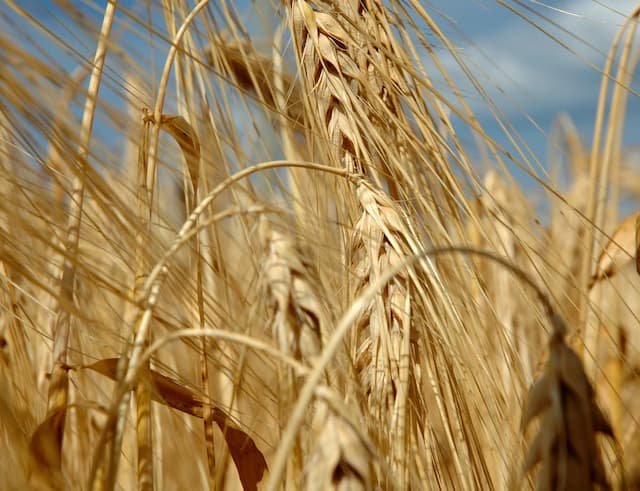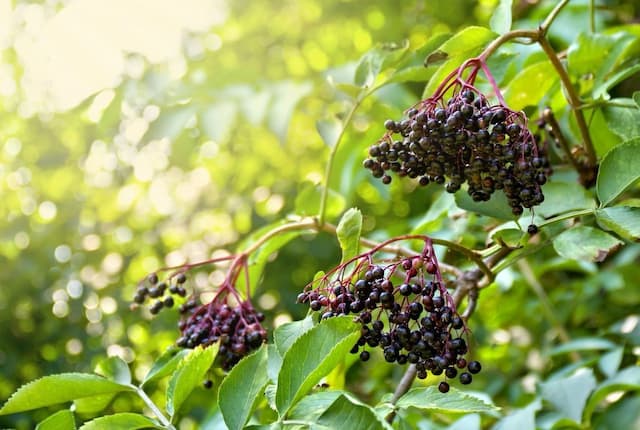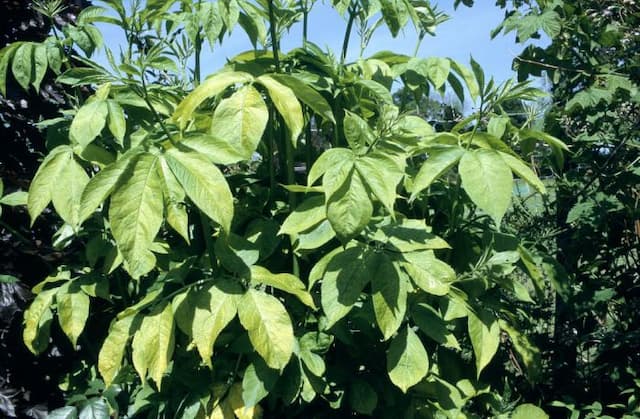Fragrant Viburnum Viburnum farreri 'Candidissimum'

ABOUT
The plant known commonly as Fragrant Viburnum features a robust and bushy appearance with a dense, rounded form. The branches are adorned with ovate-shaped leaves that have a slightly toothed margin. These leaves can boast a lush, green color during the growing season, turning to various shades of red and purple as the cooler months of fall approach. The standout feature of this plant is its prolific flowers. In the early spring, Fragrant Viburnum becomes a spectacle of bloom with clusters of delicate, star-like flowers. These pristine white blossoms are tightly packed into rounded inflorescences that emit a powerfully sweet and spicy fragrance, capable of perfuming the surrounding area. After the flowering season, the plant produces small, berry-like fruits that may attract birds and wildlife to the garden. These fruits typically start out green, turning to a black or dark blue color as they mature. The textural contrast between the flowers, the fruits, and the foliage adds to the visual interest this plant offers throughout the changing seasons.
About this plant
 Names
NamesFamily
Adoxaceae
Synonyms
Fragrant Viburnum, Farrer's Viburnum, Pink Dawn Viburnum
Common names
Viburnum farreri 'Candidissimum'.
 Toxicity
ToxicityTo humans
The Fragrant Viburnum, while not typically considered highly toxic to humans, contains small amounts of cyanogenic glycosides. These compounds can release cyanide when damaged or digested. Ingesting large quantities of leaves, stems, or berries may potentially cause mild stomach upset, with symptoms like nausea, vomiting, and diarrhea. However, severe poisoning is rare due to the low concentration of these compounds.
To pets
Similar to humans, for pets, the Fragrant Viburnum contains cyanogenic glycosides, which can release cyanide when the plant parts are chewed or otherwise damaged. If a pet ingests a substantial amount of the plant, it may experience symptoms such as vomiting, diarrhea, and lack of appetite. While toxicity is generally considered low, it is advisable to prevent pets from consuming the plant to avoid any potential adverse effects.
 Characteristics
CharacteristicsLife cycle
Perennials
Foliage type
Deciduous
Color of leaves
Green
Flower color
White
Height
6-8 feet (1.8-2.4 meters)
Spread
4-6 feet (1.2-1.8 meters)
Plant type
Shrub
Hardiness zones
4-8
Native area
China
Benefits
 General Benefits
General Benefits- Ornamental Value: The Viburnum farreri 'Candidissimum', commonly known as Fragrant Viburnum, has a decorative presence due to its beautiful white, fragrant blooms that appear in late winter or early spring.
- Wildlife Attraction: The blossoms provide an early source of nectar for pollinators such as bees, and the berries are a food source for birds.
- Seasonal Interest: This plant offers multi-season interest with flowers in spring, lush green foliage in summer, and red to purple leaves in fall.
- Screening: It can be used as a hedge or screen to provide privacy or to block undesirable views due to its dense growing habit.
- Ease of Care: Fragrant Viburnum is known for being low-maintenance and adaptable to a range of soil types, requiring minimal care once established.
- Drought Tolerant: Once established, it can tolerate periods of dryness, reducing the need for frequent watering.
- Hardy: It is a hardy plant that can withstand cold temperatures, making it suitable for a variety of climates.
- Sensory Appeal: The fragrant flowers add a sensory appeal to gardens, releasing a pleasant scent that can be enjoyed by garden visitors.
- Versatility: This Viburnum can be used in various landscape designs, including as a specimen plant, in mixed borders, or as part of foundation plantings.
 Medical Properties
Medical PropertiesThis plant is not used for medical purposes.
 Air-purifying Qualities
Air-purifying QualitiesThis plant is not specifically known for air purifying qualities.
 Other Uses
Other Uses- Floral Arrangements: The fragrant white flowers of the Viburnum farreri 'Candidissimum', commonly known as Fragrant Viburnum, can be cut and used in floral arrangements to add scent and visual appeal.
- Photography Subject: The blossoms and overall structure of the Fragrant Viburnum make it a beautiful subject for garden photographers, particularly when it's in full bloom.
- Craft Projects: Dried branches and flowers of Fragrant Viburnum can be used in making wreaths, garlands, or other decorative craft projects.
- Natural Insect Repellent: Placing cut branches of Fragrant Viburnum around outdoor living areas may help to deter certain insects, thanks to the plant's natural aroma.
- Educational Tool: Fragrant Viburnum can be used for educational purposes to teach about plant biology, pollination and the seasons, especially because it's one of the early bloomers in spring.
- Horticultural Training: Pruning the Fragrant Viburnum provides an excellent opportunity for gardeners to learn and practice pruning techniques on a forgiving shrub.
- Sound Barrier: When planted in mass or as a hedge, the thick foliage of Fragrant Viburnum can help muffle noise from streets and neighbors.
- Signature Scent Development: The fragrance of the Viburnum farreri 'Candidissimum' could be analyzed by perfumers using headspace technology to create a unique floral perfume.
- Winter Garden Interest: With its persistent berries and sometimes reddish to purple fall foliage, Fragrant Viburnum provides color and interest in winter gardens.
- Culinary Experiments: While not a common culinary ingredient, the flowers, if deemed safe, could potentially be used as garnish for special dishes, after thorough research and testing for edibility.
Interesting Facts
 Feng Shui
Feng ShuiThe Fragrant Viburnum is not used in Feng Shui practice.
 Zodiac Sign Compitability
Zodiac Sign CompitabilityThe Fragrant Viburnum is not used in astrology practice.
 Plant Symbolism
Plant Symbolism- Renewal: Viburnum farreri 'Candidissimum', commonly known as Fragrant Viburnum, often blooms early in the spring, symbolizing the renewal and revival of nature after winter.
- Purity: The 'Candidissimum' variety of Fragrant Viburnum produces pure white flowers, which are traditionally associated with innocence and purity.
- Protection: In some cultures, Viburnum species are believed to offer protection and are planted near homes to ward off evil spirits.
 Water
WaterFor the Fragrant Viburnum, it's important to establish a regular watering routine, ensuring that the soil remains consistently moist but not waterlogged. During active growth in spring and summer, water thoroughly once a week with about 1.5 gallons for a small plant or 2-3 gallons for a larger one. During the fall and winter, reduce watering to every other week, adjusting for rainfall. Make sure to check the soil moisture level before watering to prevent overwatering, as this can lead to root rot.
 Light
LightFragrant Viburnum thrives best in full sun to partial shade. It should be placed in a location where it will receive at least four to six hours of direct sunlight per day. Some dappled afternoon shade can be beneficial, especially in hotter climates, to prevent scorching of the leaves.
 Temperature
TemperatureFragrant Viburnum can tolerate a range of temperatures but does best in areas where the climate is temperate. It can survive in temperatures as low as 0°F but thrives between 60°F and 75°F. Avoid extreme heat above 95°F, as it may stress the plant. Providing a location with some protection from harsh winter winds will help the plant stay healthy.
 Pruning
PruningPruning the Fragrant Viburnum is important for maintaining its shape and promoting healthy growth. The best time for pruning is immediately after the shrub finishes blooming in late spring or early summer, which encourages new flower buds for the next year. Remove any dead or diseased wood, thin out crowded branches, and shape the plant as desired. Prune every year to ensure the plant remains vibrant and flowering profusely.
 Cleaning
CleaningAs needed
 Soil
SoilFragrant Viburnum requires well-draining soil with a lot of organic matter. A good mix could be equal parts of garden soil, compost, and peat or perlite to ensure drainage. Ideally, the soil pH should be slightly acidic to neutral, ranging from 5.6 to 7.5.
 Repotting
RepottingFragrant Viburnum is typically grown outdoors and doesn't require frequent repotting. If grown in containers, repot every 2-3 years in the spring to refresh the soil and accommodate root growth.
 Humidity & Misting
Humidity & MistingThe Fragrant Viburnum thrives in average outdoor humidity levels. While specific humidity requirements are not strict, this plant performs well in the typical range found in its natural outdoor environment.
 Suitable locations
Suitable locationsIndoor
Place in bright, indirect light and ensure good air circulation.
Outdoor
Plant in sun to part shade, amended soil, mulch well, water regularly.
Hardiness zone
4-8 USDA
 Life cycle
Life cycleViburnum farreri 'Candidissimum', commonly known as Fragrant Viburnum, begins its life cycle when a seed germinates in late spring to early summer, given moist soil conditions and partial to full sunlight exposure. The seedling then develops into a juvenile plant, characterized by rapid vegetative growth where it establishes its root system and foliage. As it matures into an adult shrub, usually within several years, it begins to bloom, producing fragrant white flowers in late winter to early spring, which is one of its most notable stages for gardeners. After pollination, which is usually facilitated by insects, the flowers develop into small red berries that later mature to black, attracting birds and other wildlife. These berries contain seeds that may disperse, starting the cycle anew if conditions allow for germination. The plant reaches its senescence stage over several years, where growth slows, and it may eventually die, often after many years since Viburnum species can have a long lifespan if given proper care.
 Propogation
PropogationPropogation time
Late Winter - Early Spring
Propogation: The most popular method of propagation for the Viburnum farreri 'Candidissimum', also known as Fragrant Viburnum, is through softwood cuttings. This technique is ideally undertaken in late spring to early summer when the plant's new growth is just beginning to harden, or mature. Cuttings should be approximately 4 to 6 inches (10 to 15 centimeters) in length, and the bottom leaves should be removed. A rooting hormone can be applied to the cut end to encourage root development. The cutting is then placed in a well-draining potting mix and kept moist and under indirect light until roots have established, which typically takes a few weeks. Once rooted, the new plants can be gradually acclimated to outdoor conditions and then transplanted to their final location in the garden.




![Elder [Black Tower]](/_next/image?url=https%3A%2F%2Fplants-admin.emdemapps.com%2Fimages%2Fplants%2F%2Fimages%2F604b5cad99578.png&w=640&q=75)




